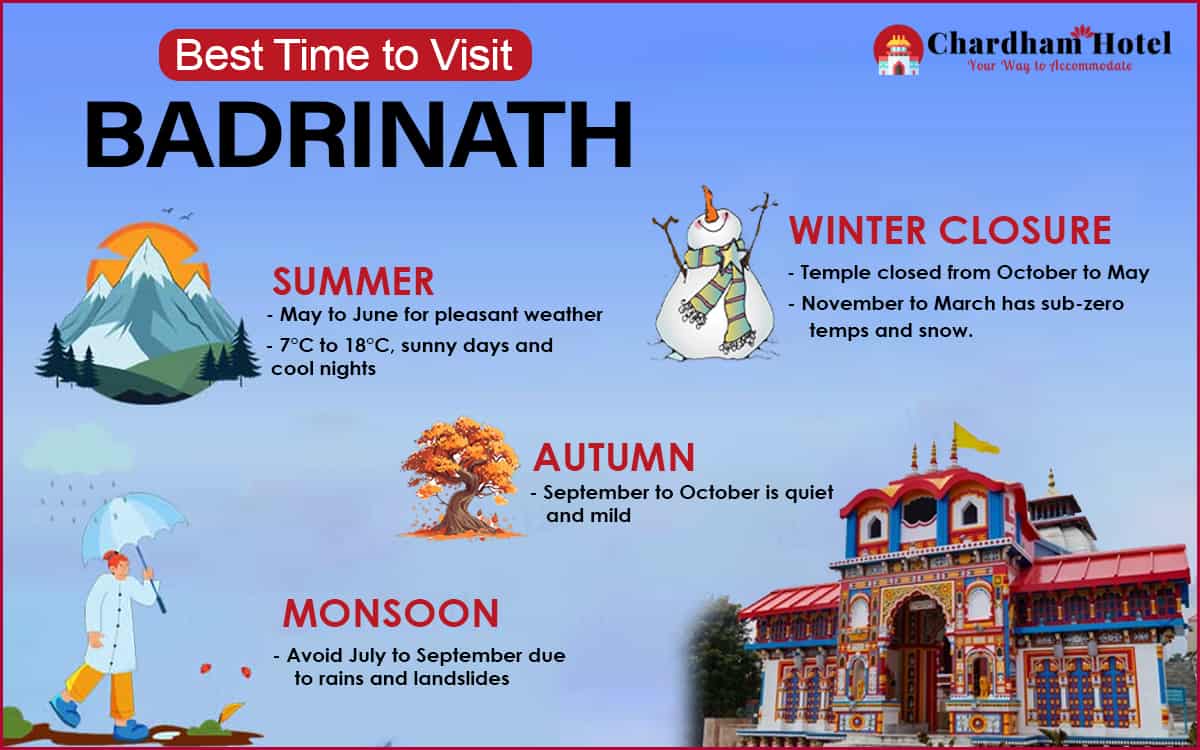Nestled amidst the majestic Himalayan mountains, Badrinath stands as a beacon of spirituality, drawing pilgrims and seekers from all corners of the globe. Dedicated to Lord Vishnu, the Badrinath temple, situated in the Chamoli district of Uttarakhand, is a pivotal stop on the sacred Chardham Yatra. However, this divine abode experiences diverse climatic conditions throughout the year, making it essential for travelers to time their visit wisely. In this guide, we unravel the intricacies of Badrinath’s climate and unveil the optimal seasons for a transformative pilgrimage.

Understanding the Climate
Badrinath’s climate is characterized by its high altitude, which contributes to its unique weather patterns. Winters are harsh, with temperatures plummeting to sub-zero levels, while summers offer a respite from the biting cold with pleasantly cool days. Monsoons bring heavy rainfall, posing challenges for travel due to the risk of landslides. Here’s a breakdown of the temperature ranges across different seasons:
- Summer (March to June): With temperatures ranging from 7°C to 18°C, summer heralds the most favorable conditions for visiting Badrinath. Days are sunny, offering comfortable exploration opportunities, while nights retain a refreshing chill.
- Monsoon (July to September): Monsoon spells caution for travelers, as heavy rainfall and the looming threat of landslides necessitate the closure of the Badrinath temple. Temperatures hover around 5°C to 15°C, with cooler nights adding to the challenge of navigating the terrain.
- Winter (October to April): The winter season in Badrinath is unforgiving, with temperatures dipping as low as 1°C to 14°C, and sometimes plunging below zero. Heavy snowfall blankets the region, rendering it inaccessible for pilgrims, and leading to the closure of the temple before the onset of October.
Best Time to Visit
- Summer Serenity (May to June): As the snow begins to melt and the landscape awakens, May and June emerge as the prime months to embark on a spiritual odyssey to Badrinath. With temperatures conducive to exploration and clear skies offering uninterrupted vistas of the Himalayas, this period beckons pilgrims in large numbers.
- Tranquil Transitions (September to October): For those seeking a quieter, more introspective pilgrimage experience, the post-monsoon months of September and October provide a serene backdrop. As the tourist rush subsides, the weather remains pleasant, allowing for profound spiritual communion amidst nature’s tranquility.

Month Wise Weather Conditions & Temperature
- April: Experience moderately cold weather with temperatures ranging from around 5°C to 15°C, ideal for spiritual endeavors amidst the awakening landscape of spring.
- May: Witness the warmth of the season as the temple opens its gates, offering picturesque views of the snow-capped peaks, with temperatures ranging from 7°C to 18°C.
- June: Enjoy mild weather and vibrant blooms, making it one of the best times to visit Badrinath, with temperatures ranging from 8°C to 20°C.
- July: Brace for heavy rainfall and the closure of the temple due to safety concerns posed by landslides, with temperatures ranging from 5°C to 15°C.
- August: Encounter occasional showers amidst cautious travel advisories, marking a transitional phase in the weather, with temperatures ranging from 5°C to 15°C.
- September: Embrace lingering humidity as autumn approaches, signaling the beginning of a quieter pilgrimage season, with temperatures ranging from 5°C to 15°C.
- October: Feel the chill in the air as temperatures drop, heralding the end of the pilgrimage season before the onset of winter, with temperatures ranging from 1°C to 14°C.
- November to March: Prepare for extreme cold and heavy snowfall, rendering Badrinath inaccessible and the temple closed to pilgrims, with temperatures dipping well below freezing, often reaching sub-zero levels.
Planning Your Journey
To ensure a seamless pilgrimage to Badrinath, it’s imperative to align your visit with the temple’s opening and closing dates, which are determined by the Mandir Samiti. While May marks the anticipated reopening of the temple gates, closure typically precedes the onset of winter, signaling the end of the pilgrimage season. By consulting the Badrinath Weather Guide, pilgrims can gain valuable insights into the climatic conditions across different months, enabling them to plan their journey with precision.
FAQ’s
Q-1: When is the best time to visit Badrinath for pleasant weather?
Ans: The best time for pleasant weather is during May and June, with mild temperatures ideal for exploration.
Q-1: Which months should I avoid due to extreme weather?
Ans: Avoid visiting from November to March, as heavy snowfall and extreme cold make travel difficult.
Q-1: When does the temple close and reopen for pilgrims?
Ans: The temple closes around October and reopens in May after winter snow melts.
Q-1: What are the risks of visiting during the monsoon season?
Ans: Monsoon months (July to September) bring heavy rainfall and landslides, leading to temple closures.
Q-1: Are there quieter times to visit for a more serene experience?
Ans: September and October offer fewer crowds and pleasant weather post-monsoon.
Conclusion
Badrinath, with its ethereal beauty and profound spiritual resonance, stands as a testament to the enduring allure of the sacred. Whether bathed in the golden hues of summer or veiled in the icy embrace of winter, this hallowed abode beckons seekers on a transformative quest for inner awakening. By heeding the insights offered in this guide, pilgrims can navigate the nuances of Badrinath’s climate and embark on a journey that transcends the bounds of time and space, leading them closer to the divine.
Also Read:

 Call
Call WhatsApp
WhatsApp Enquiry
Enquiry